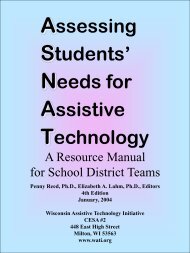Extended School Year Services (ESY) - The Special Education Team
Extended School Year Services (ESY) - The Special Education Team
Extended School Year Services (ESY) - The Special Education Team
Create successful ePaper yourself
Turn your PDF publications into a flip-book with our unique Google optimized e-Paper software.
Background Information<br />
SCENARIO: BEAU<br />
7/1999<br />
Revised 8/2004<br />
Beau is a 4 year, 5 month old male who was referred for special education services from<br />
the private PreK program he attended. <strong>The</strong> main concern of his PreK teachers was his<br />
behavior, especially during instructional time and transitions. Upon evaluation, it was<br />
determined that Beau had two areas in which he met eligibility for Significant<br />
Developmental Delay-- cognitive and adaptive behavior. Beau's IEP services, ten hours<br />
per week, were provided directly in the private PreK program. <strong>The</strong> Pre-K teacher<br />
collaborated with the special education teacher and implemented behavioral and<br />
instructional strategies during the periods the special education teacher was not in the<br />
room.<br />
<strong>The</strong> main focus of the preschool special education services provided to Beau included<br />
maintaining appropriate behavior and providing some basic academics. During the<br />
school year, Beau has made progress. He is now able to complete two-step directions<br />
accurately, but he is inconsistent in completing three-step directions. He is able to<br />
recognize his name but unable to name any of the letters of the alphabet. Beau can<br />
name three shapes and four colors consistently.<br />
A behavior modification plan was implemented to increase Beau's appropriate behavior.<br />
<strong>The</strong> plan, based on a token system, involved stickers which were given for appropriate<br />
behavior and could be exchanged for small toys, edibles, or extra play at the end of the<br />
day. This system was in place for all of the children in the class. Beau's behavior<br />
improved during the year. When given a signal before transition times, Beau learned to<br />
stop what he was doing and wait for further directions. However, this behavior was not<br />
consistent during play and lunch times. When asked to stop an inappropriate behavior,<br />
such as playing in a center not assigned or playing during instructional times, Beau<br />
would still tantrum. Tantrums included loud vocalizations, kicking, attempts to bite,<br />
and pulling away from adults. <strong>The</strong> frequency of the tantrums reduced, however, from<br />
fifteen per week to three, with periodic weeks of no tantrums. When tantrums occurred,<br />
an examination of the situation usually revealed that the teacher did not provide time<br />
for transition. Beau was observed playing appropriately with peers for five-minute<br />
spans of time, but would occasionally take items without asking.<br />
IEP <strong>Team</strong><br />
<strong>The</strong> IEP team met to review Beau's goals and objectives, which addressed the following<br />
areas:<br />
• Completing two- and three-step directions.<br />
• Naming five shapes and colors.<br />
• Maintaining appropriate behavior during transitions.<br />
• Maintaining appropriate behavior when redirected.<br />
CESA #9: 1999 Determining <strong>ESY</strong> <strong>Services</strong>, Revised 2004 22











